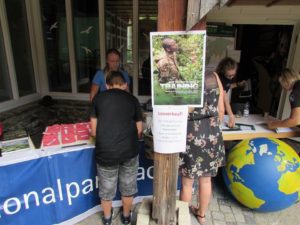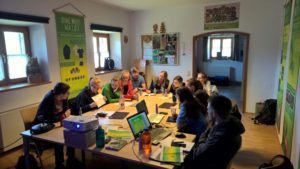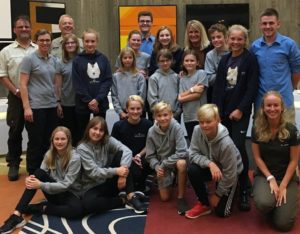Junior Ranger Case Studies: The Bavarian Forest National Park
To provide guidance and information on how to run the Junior Ranger programme, EUROPARC started to gather case studies describing how the programme is structured and managed in different parks.
These case studies, in form of short interviews, are mainly intended to provide inspiration and ideas to Protected Areas willing to start the programme.
About Junior Ranger Bavarian Forest
Our Junior Ranger (JR) program starts at the age of 11 at the end of the 5th class. Kids can accompany a ranger during Pentecost or Summer Holidays for 4 days, it usually runs from Monday till Thursday. The groups are of 7 kids max, accompanied by a ranger and a Volunteer ranger. They don’t stay over night – kids are brought by their parents in the morning and picked up in the afternoon.
They usually visit one of our information centres, the animal enclosures, go for hikes and get to know their Protected Area. The parents pay 10 € contribution for expenses. The kids get a JR cap, a button and our updated JR booklet.
As our Junior Rangers get older and know more about the park, they take over more responsibility and become Volunteer Rangers.
After they finish these 4 days, there is a closing ceremony where they get a certificate showing that they are now real Junior Rangers, which is also included in the 10 €. If they want, they can join our association (annual membership is 12 € per person). If they do so, they get invitations for monthly meetings with a ranger. We usually have two groups as the park is very large and it would take a lot of time for parents if they only meet in one point. Only sometimes we do activities for the whole group.

They go hiking both in summer and winter, build nesting boxes, learn about endangered species living in the park and so on… As they get older and know more about the park, they take over more responsibility and at the age of about 16, we call them Volunteer Rangers. At that age, they help rangers with ranger tasks (at information stands, patrols, informing visitors, with the JR program etc.).
How do you recruit young people? How many Rangers/Mentors are involved and how many Junior Rangers?
In spring, our rangers visit the schools in the Park vicinity and invite all kids in 5th class to join us for the 4 days. They get a leaflet with all the necessary information and a form they can fill out and send back to us to register for the 4 days (we limited the number of participants to 120 kids a year).
For the basic program, there are about 10 rangers taking over a group of Junior Rangers. During the year, we have a group of 5 constant rangers running the activities with alternating rangers assisting in some activities. The number of Junior Rangers participating varies – sometimes there are only 5, other times there are 20.
How are your activities organised?
Both local groups meet about once a month (sometimes it’s less during summer due to the basic program).

Sometimes it‘s only an afternoon, other times it‘s a whole day. The constant rangers usually talk about the activity they prepare and set up a plan (what’s the topic of the activity, which material do we need, what would we like to teach the kids etc.). Rangers help each other and give tips to make every activity a success.
What are the main results and benefits for young people and for the Protected Area?
Better acceptance of the park in the area, the park gets highly motivated and well-trained volunteers who are assisting in different fields (research, ranger services etc.).
Concerning benefits for the young people, they’re outside which is good for their health, they are more confident, well trained, gather experience which might be helpful in their later life, decision support in their later field of study or choice of work and future workplace.
With the JR Programme, the park gets highly motivated and well-trained volunteers who can assist in different fields.
What are the main costs and how do you finance them?
I think we might be a special case as we have set up a registered association in Germany. This means, we are independent from the park in terms of money. We finance ourselves through membership fees, donations and sale of merchandise. I think our biggest expense factor are the journeys to national / international camps. We try to offer it to our Junior Rangers at no cost but sometimes the parents need to pay a small amount. We also have a website for the association that is financed by us.

Is there any other information that you think would be useful to share?
You can download a PDF with a presentation about our JR programme. If you need any more information, feel free to contact me at any time: kris.biebl@web.de.
Do you also want to share your experience with running the Junior Ranger Programme in your park? We will be happy to spread your ideas around – just drop us a mail: f.minozzi@europarc.org
